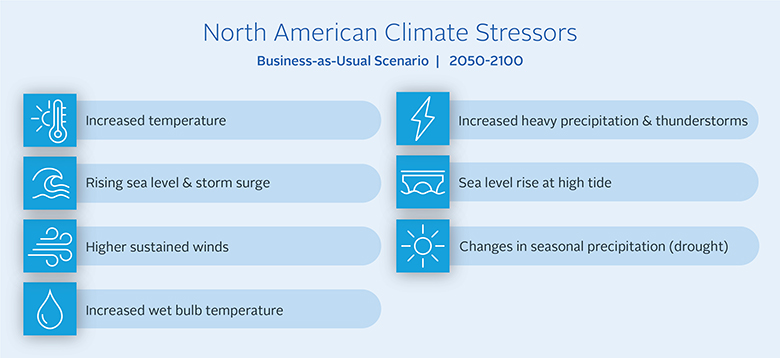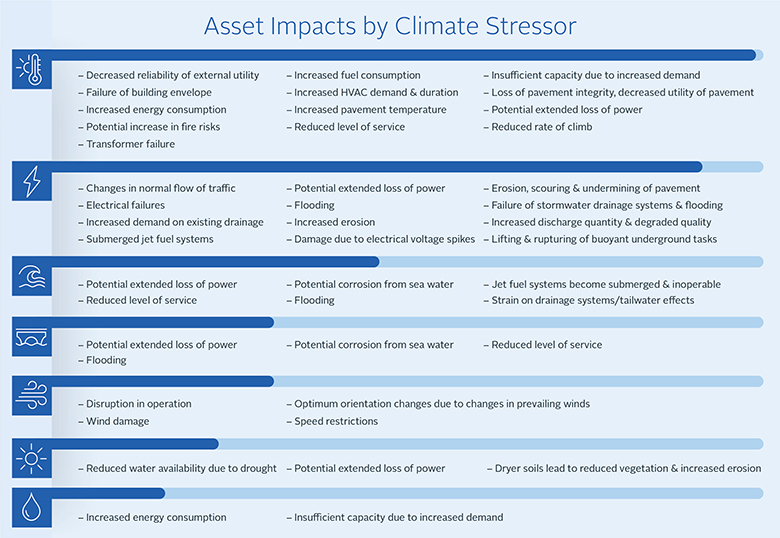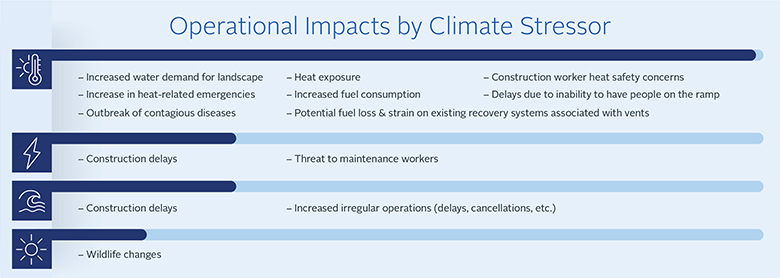Climate Change: A Crisis Airports Can Begin To Prepare for Now

As COVID-19 impacts our industry and our world in ways never seen before, we’re faced with the uncomfortable reality of what can happen when an unforeseen event strikes.
COVID-19 is unlikely to be the only challenge we face in the coming decade. While not as acute as COVID-19, climate change is a chronic occurrence that will increasingly impact airports over the coming decades.
The good news is that with infrastructure investments likely to occur during the Biden administration, airport sponsors can take small but powerful steps to overcome climate change’s impact on their facilities and operations.
The Certainty of Climate Change
Climate change and extreme weather events adversely affect airports today and will continue to do so over the coming decades. While impacts may be both acute and chronic, we can prepare now by understanding vulnerabilities and incrementally mitigating as opportunities arise through existing planning and construction projects.
Even small steps will go a long way in lessening financial and operational impacts until your airport can achieve holistic resilience to climate change. For example, the RS&H-designed tide gate replacement project at PHL considered future precipitation conditions, resulting in reduced flooding potential for the project’s drainage area.
In addition to preventing operational and financial impacts, natural hazard mitigation is believed to save airports money – $6 on average for every $1 spent mitigating, according to an analysis by the National Institute of Building Sciences.
Why You Should Act Now
Secure your finances
The United States House of Representatives’ INVEST in America Act this past summer included a requirement that infrastructure built with the funding accounted for climate change impacts.
The bill was not considered by the United States Senate. However, the inclusion of climate change mitigation and resilience considerations in this draft underscores a shift in thinking around federal funding for all modes of transportation, including airports.
The incoming Biden administration has signaled a strong connection between needed infrastructure improvements and sustainability and resiliency priorities. In addition, climate change vulnerability is increasingly seen as a financial weakness for our public infrastructure (roads, transit, rail – and of course, airports), which could affect credit ratings.
Just this year, Moody’s issued a research report about airports vulnerable to climate change. Standard & Poor’s released a similar report this November.
Investors and financial institutions are also recognizing climate change hazards and seeking disclosures in bond documents, with organizations like the Task Force on Climate-Related Financial Disclosure (TCFD) establishing a consistent reporting framework.
The bottom line: creating resilient, sustainable infrastructure incrementally where possible can help combat climate change vulnerability – and protect credit ratings, insurability and the availability of funding in the future.
Ready your infrastructure
You may not be ready to complete an adaptive management plan or climate action plan for several years. But you can still include climate considerations in upcoming infrastructure projects.
The infrastructure you design, construct or plan today can help your airport infrastructure support future climate change impacts and improve your ability to address vulnerabilities.
For instance, while runways are designed for a 20-year lifespan, their placement and orientation are very long-term. As a result of increased heat caused by climate change, aircraft in some areas are going to need longer runways in the future.
Since land around airports is valuable and sought-after, it’s best you recognize now that you may need additional land in the future for runway extensions or safety and noise areas.
Incorporating these long-term infrastructure concerns into your plans or designs today has minimal financial impacts compared to the benefits – which include saving you a lot of money and headaches in the future.
Protect your operations
Some airports are already experiencing the impacts of climate change, and typical outside activities like maintenance and construction are being impacted by more extreme temperatures.
In certain regions, extreme temperatures make working outside for long periods of time during the day increasingly untenable, resulting in less productivity and increased costs.
Additionally, the ability to operate existing infrastructure as designed could be at risk.
For example, higher and more frequent sustained winds are likely to occur over the next few decades, and any elevated operations (people movers, control towers, etc.) that have not been designed to withstand higher wind conditions may be at risk. Surprisingly, sustained winds as low as 40 and 50 miles per hour can impact some elevated operations.
Initially, these impacts will mean operations stopping and inconvenience to tenants and passengers. Long-term, the effect could be substantial resulting in higher operating costs and more system impacts.
When opportunities arise for infrastructure projects, it’s important you consider these kinds of infrastructure that may affect future operations.
Investigate your regional support network
Your airport is served by roads and utilities beyond your direct responsibility, but if they are adversely impacted by climate change and severe weather events, the airport may lose functionality.
Not only do your passengers need to get to the airport safely, but your employees do as well. You are intricately connected to other entities in your area and the services they provide.
Airports are taking great strides to reduce greenhouse gas emissions by transitioning to electric fleets, eGSE and gate services. But if the electric power supply is interrupted because of climate change stresses, how will your airport function?
Identifying regional vulnerabilities and coordinating with those regional agencies to start to address the challenge will help ensure your airport remains resilient.
With stimulus and infrastructure investment on the way, having these conversations now means the regional sustainability and resiliency needs you’ve identified are more likely to be added to the infrastructure to-do list.
Start Now, Start Small
Creating a plan that identifies climate change-induced severe weather vulnerabilities and available adaptation measures – and which can be implemented incrementally – is key to your long-term success. Undoubtedly, it will improve your airport’s resilience and save response costs.
But even the small actions you take with upcoming government-funded infrastructure projects will have big impacts on your infrastructure, finances and operations in the future, making our national aviation system more resilient.
RS&H offers Environmental, Stewardship, & Resiliency services as part of our aviation architecture, engineering and consulting work. Learn how we can help you plan for stimulus infrastructure projects by reaching out to John Lengel at John.Lengel@rsandh.com or by calling 380-777-6040.







